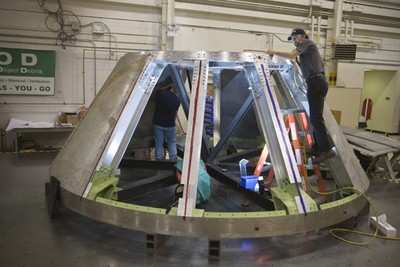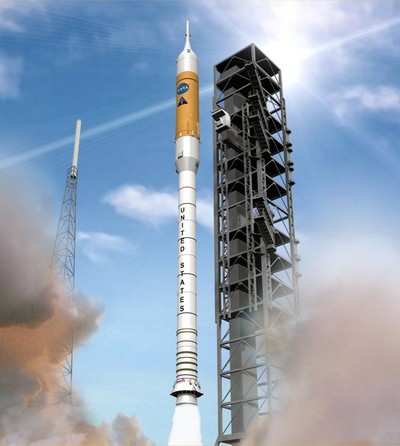Dummy Crew Launch Vehicle Will Fly Atop Ares I-X Test
NASA is one step closer to the first flight test of the rocket
that will send humans on their way to the moon as part of the
agency's Constellation Program. Rocket hardware critical for the
test, known as Ares I-X, was completed this week at NASA's Langley
Research Center in Hampton, VA.

The flight of Ares I-X will be an important step toward
verifying analysis tools and techniques needed to develop Ares I,
NASA's next crew launch vehicle.
The Langley-designed and built hardware is engineered to
represent the Orion crew module and a launch abort system that
increases crew safety. In late January, the rocket elements will be
shipped from Langley to NASA's Kennedy Space Center in Florida.
This hardware and other elements from around the country will be
integrated into the Ares I-X rocket, the first in a series of
unpiloted test vehicles.
The test launch is scheduled to lift off from Kennedy during the
summer of 2009. It will climb about 25 miles in altitude during a
two-minute powered flight, continuously measuring vehicle
aerodynamics, controls and performance of the rocket's first stage.
The launch will culminate with a test of the separation of the
first stage from the rocket and deployment of the accompanying
parachute system that will return the first stage to Earth for data
and hardware recovery.
"This launch will tell us what we got right and what we got
wrong in the design and analysis phase," said Jonathan Cruz, deputy
project manager at Langley for the Ares I-X crew module and launch
abort system. "We have a lot of confidence, but we need those two
minutes of flight data before NASA can continue to the next phase
of rocket development."

The simulated crew module and launch abort system will complete
the nose of the rocket. About 150 sensors on the hardware will
measure aerodynamic pressure and temperature at the nose of the
rocket and contribute to measurements of vehicle acceleration and
angle of attack. The data will help NASA understand whether the
design is safe and stable in flight, a question that must be
answered before astronauts begin traveling into orbit and
beyond.
To ensure the rocket's flight characteristics are understood
fully, extreme care was taken to fabricate the simulated crew
module and launch abort tower precisely. To compare flight results
with preflight predictions confidently, these full-scale hardware
components needed to be accurate reflections of the shape and
physical properties of the models used in computer analyses and
wind tunnel tests.
The simulated crew module is a full-scale representation of the
vehicle that will ferry astronauts to the International Space
Station by 2015, to the moon in the 2020s and, ultimately, to
points beyond. The conical module has the same basic shape as the
Apollo module but, at approximately five meters in diameter, is
significantly larger. The launch abort system simulator is 46 feet
in length. It will fit over the crew module and tower above it,
forming the nose of the rocket.
Researchers and managers at Langley worked to overcome multiple
challenges as the Orion crew module and launch abort system
simulators took shape. One team performed fabrication and assembly
work in conjunction with an off-site contractor, and another team
installed the sensors once the crew module and launch abort tower
were completed.

"We are a highly matrixed team -- a lot of people from various
organizations -- that had to work together successfully on a tight
schedule," said Kevin Brown, project manager at Langley for the
Ares I-X crew module and launch abort system project.
 Aero-News: Quote of the Day (11.20.25)
Aero-News: Quote of the Day (11.20.25) ANN's Daily Aero-Term (11.20.25): Overhead Maneuver
ANN's Daily Aero-Term (11.20.25): Overhead Maneuver ANN's Daily Aero-Linx (11.20.25)
ANN's Daily Aero-Linx (11.20.25) NTSB Prelim: Just Highlander
NTSB Prelim: Just Highlander Classic Aero-TV: Just Like The 'Real' Thing Redbird/Disneys Dusty FlightSim
Classic Aero-TV: Just Like The 'Real' Thing Redbird/Disneys Dusty FlightSim





